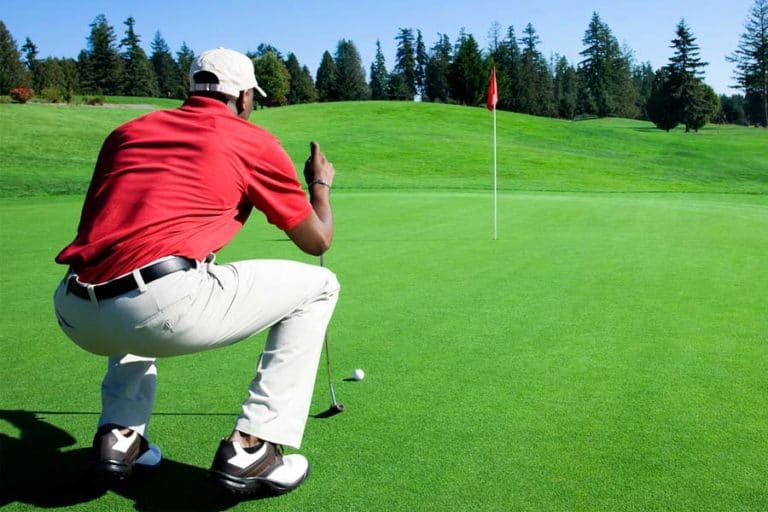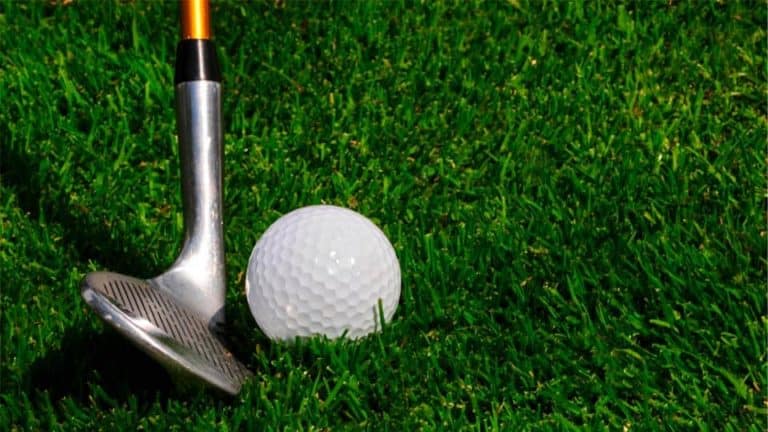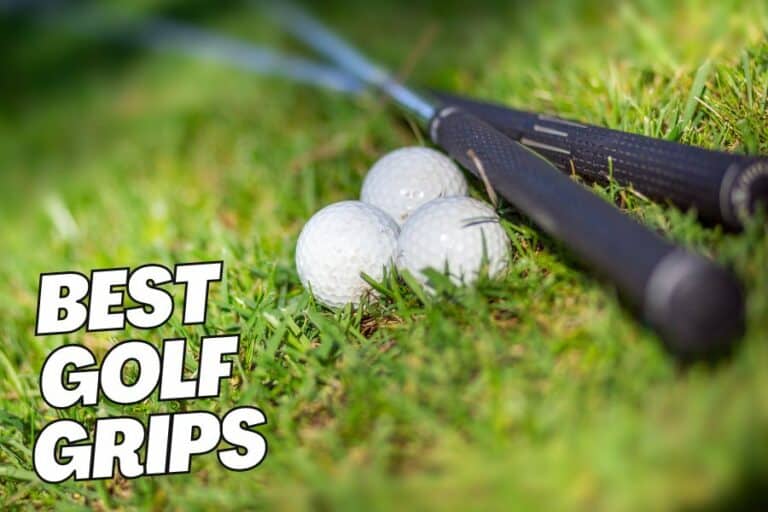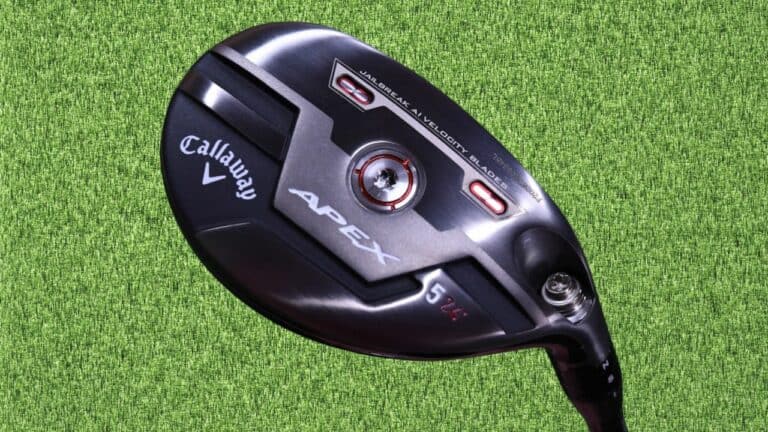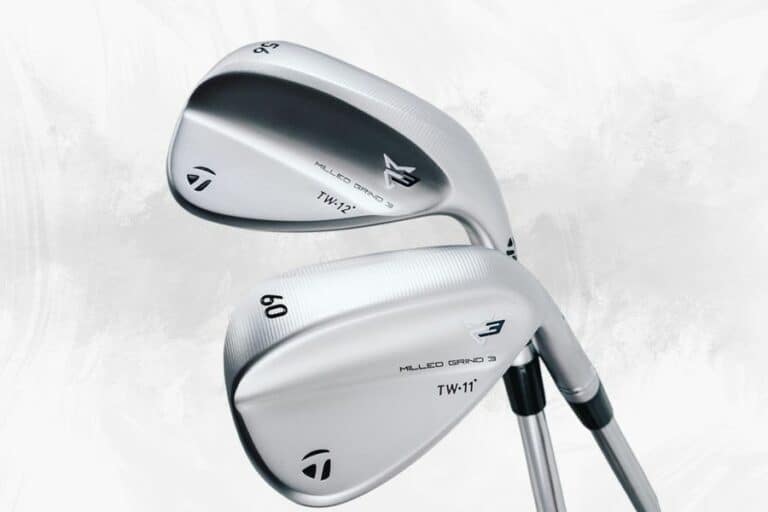Golf Ball Compression Chart: Based On Swing Speed And Skills
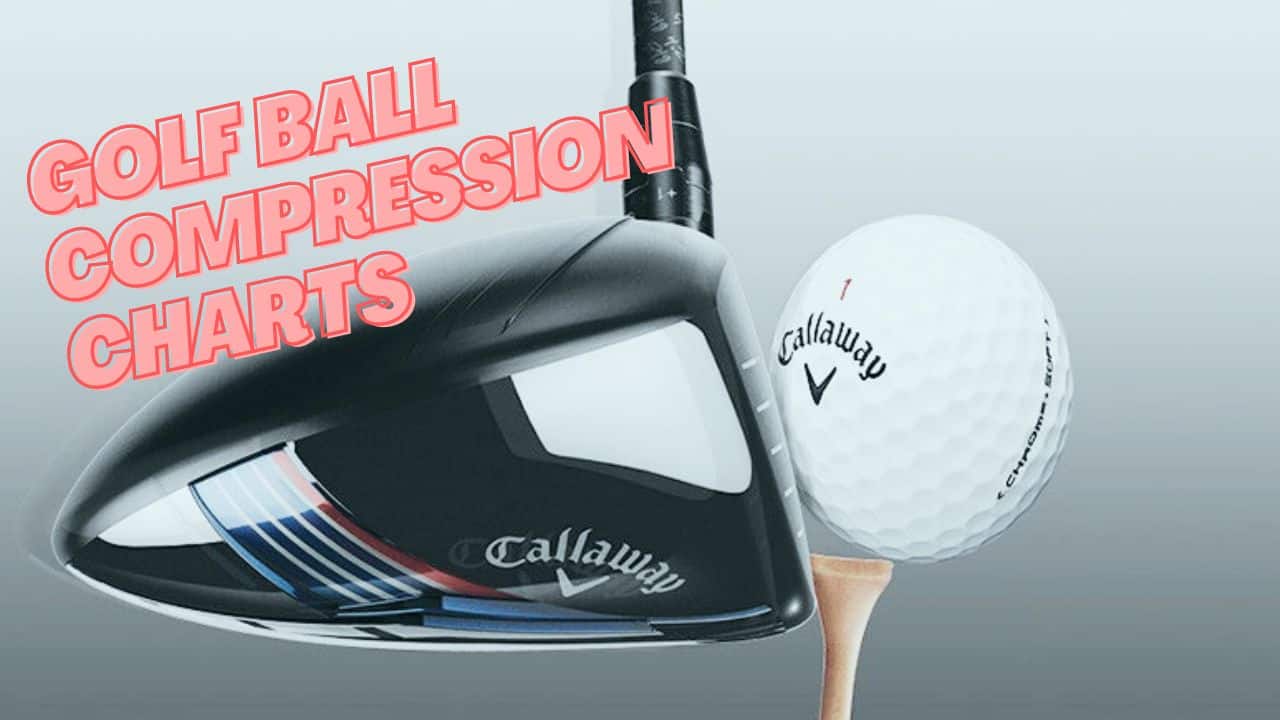
Golf ball compression plays a crucial role in how a ball reacts when struck. Choosing the right golf ball compression can significantly impact your game, as it influences distance, spin, feel, launch angle, and other important factors.
It’s essential to recognize that not all golf balls are created equal, each brand and model come with different compression ratings. Therefore, considering golf ball compression chart is important when purchasing golf balls.
I. What is golf ball compression?
Golf ball compression is the measure of how much a golf ball deforms and changes shape when struck by a club. It describes the interaction between the clubface and the ball’s core. The lower the compression, the softer the ball, and the higher the compression rating, the harder the ball. Typically, the golf ball compression ranges between 30 to 120.
- Softest golf ball: 30
- Hardest golf ball: 120.
II. Compression ratings based on swing speeds
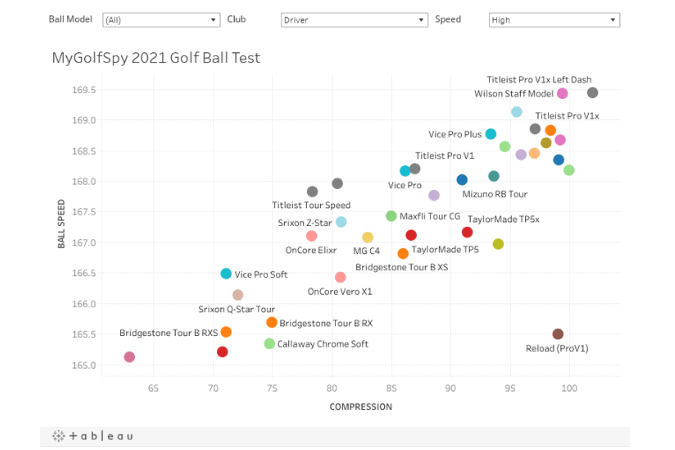
To better understand the right golf ball compression for your game, you should consider your swing speed. The below table will help you to decide the right golf ball compression for your game.
| Ball Type | Compression Rating | Player Skill | Swing Speed |
| Soft golf ball | 30-70 | Beginner or high handicapper | <85 |
| Medium compression golf ball | 80-90 | Intermediate or mid-handicapper | 85-105 |
| Hard or firm golf ball | 90-120 | Advanced or low-handicapper | Above 105 |
III. Golf ball compression chart: Popular golf balls
Here is a comprehensive golf ball compression chart featuring popular golf ball brands available in the market, classified into three categories: high, medium, and low compression golf balls.
1. High compression golf balls
| Golf Ball | Compression | Layers | Cover | Short game spin | Recommended Swing speed | Handicap |
| Bridgestone Tour B X | 98 | 3 | Urethane | high | 105+ mph | low |
| Callaway Chrome Soft X | 95 | 4 | Urethane | high | 105+ mph | low |
| Callaway Chrome Soft X LS | 100 | 4 | Urethane | high | 105+ mph | low |
| Callaway Warbird | 90 | 2 | Ionomer | Mid | <95 mph | mid-low |
| Cut DC | 105 | 4 | Urethane | high | 105+ mph | Low |
| Cut Blue | 90 | 4 | Urethane | high | <105 mph | Low |
| Mizuno RB Tour | 90 | 4 | Urethane | high | <105 mph | Low |
| Mizuno RB Tour X | 110 | 4 | Urethane | high | 105+ mph | Low |
| Snell MTB-X | 95 | 3 | Urethane | high | 105+ mph | low |
| PXG Xtreme Premium | 92 | 3 | Urethane | high | 100+ mph | mid-low |
| Srixon Z-Star | 90 | 3 | Urethane | high | <105 mph | low |
| Srixon Z-Star XV | 95 | 4 | Urethane | mid | 100+ mph | low |
| Srixon Z-Star Diamond | 100 | 3 | Urethane | high | 105+ mph | low |
| Taylormade TP5X Pix | 98 | 5 | Urethane | high | 105+ mph | Low |
| Taylormade TP5X | 98 | 5 | Urethane | high | 105+ mph | Low |
| Titleist Pro V1 X | 100 | 4 | Urethane | high | 105+ mph | Low |
| Titleist Pro V1x Left Dash | 102 | 4 | Urethane | high | 105+ mph | Low |
| Titleist Pro V1x Left Dot | 90 | 3 | Urethane | high | <105 mph | Low |
| Vice Pro Plus | 95 | 4 | Urethane | high | 110+ mph | Low |
| Volvik S4 | 95 | 4 | Urethane | high | 105+ mph | Low |
| Volvik XT AMT | 90 | 3 | Ionomer | mid | <105 mph | Mid |
| Volvik Magma | 90 | 3 | Ionomer | low | 90 mph | Mid-high |
| Wilson Staff Model | 100 | 4 | Urethane | high | 105+ mph | Low |
| Wilson Staff Model R | 100 | 4 | Urethane | high | 105+ mph | Low |
2. Medium compression golf balls
| Golf Ball | Compression | Layers | Cover | Short game spin | Recommended Swing speed | Handicap |
| Bridgestone Tour B XS | 85 | 3 | Urethane | high | 105+ mph | low |
| Cut Grey | 80 | 3 | Urethane | mid | <100 mph | mid |
| Snell MTB-Black | 85 | 3 | Urethane | mid | <105 mph | low |
| Taylormade TP5 Pix | 87 | 5 | Urethane | high | 105+ mph | Low |
| Taylormade Tour Response | 71 | 3 | Urethane | mid | <100 mph | mid |
| Taylormade Project (a) | 70 | 3 | Urethane | mid | <95 mph | high |
| Titleist Pro V1 | 87 | 3 | Urethane | high | <105 mph | low |
| Titleist AVX | 80 | 3 | Urethane | mid | <105 mph | low-mid |
| Titleist Tour Speed | 80 | 3 | Urethane | mid | <100 mph | mid |
| Vice Pro | 85 | 3 | Urethane | high | 95-110 mph | low-mid |
| Vice Pro Zero | 80 | 3 | Urethane | high | <100 mph | low-mid |
| Volvik S3 | 85 | 3 | Urethane | high | <105 mph | low |
| Wilson Triad | 85 | 3 | Urethane | mid | <100 mph | mid |
| Wilson Tour Velocity Distance | 85 | 2 | Surlyn | low | <100 mph | high |
3. Low compression golf balls
| Golf Ball | Compression | Layers | Cover | Short game spin | Recommended Swing speed | Handicap |
| Bridgestone Tour B RX | 75 | 3 | Urethane | high | <105 mph | mid |
| Bridgestone Tour B RXS | 65 | 3 | Urethane | high | <105 mph | mid |
| Bridgestone e12 Speed | 75 | 3 | Surlyn | mid | 105+ mph | mid-low |
| Bridgestone e12 Contact | 60 | 3 | Ionomer | mid | <105 mph | mid |
| Bridgestone e6 | 45 | 2 | Ionomer | low | <105 mph | high |
| Bridgestone Lady Precept | 50 | 2 | Ionomer | low | <90 mph | high |
| Bridgestone Laddie Extreme | 30+ | 2 | Ionomer | low | <90 mph | high |
| Callaway Chrome Soft | 75 | 3 | Urethane | high | <100 mph | low |
| Callaway Supersoft | 40 | 2 | Hybrid | low | <90 mph | high |
| Callaway ERC Soft | 60 | 3 | Hybrid | mid | <95 mph | mid-high |
| Callaway Supersoft Max | 30 | 2 | Hybrid | low | <85 mph | high |
| Callaway Superhot | 70 | 3 | Ionomer | low | <90 mph | high |
| Callaway Strata Eagle | 30 | 2 | Ionomer | low | <90 mph | high |
| Callaway Reva | 30 | 2 | Ionomer | low | <85 mph | high |
| Cut Red | 60 | 2 | Ionomer | low | <90 mph | high |
| Cut Matte | 65 | 3 | Ionomer | mid | <100 mph | mid |
| Mizuno RB 566 | 30 | 2 | Ionomer | low | <95 mph | high |
| Mizuno RB 566 V | 30 | 3 | Ionomer | mid | <95 mph | mid |
| Snell Get Sum | 30 | 2 | Surlyn | low | <90 mph | high |
| Srixon Q-Star | 72 | 2 | Urethane | low | <95 mph | mid |
| Srixon Q-star Tour | 72 | 3 | Urethane | mid | <95 mph | mid |
| Srixon Soft Feel | 60 | 2 | Ionomer | low | <90 mph | high |
| Taylormade Soft Response | 50 | 3 | Ionomer | low | <95 mph | high |
| Taylormade Noodle Long And Soft | 35 | 2 | Surlyn | low | <90 mph | high |
| Taylormade Distance+ | 77 | 2 | Ionomer | low | <100 mph | high |
| Titleist Tour Soft | 65 | 2 | Ionomer | Mid | <95 mph | high |
| Titleist Velocity | 65 | 2 | Surlyn | low | <95 mph | high |
| Titleist TruFeel | low | 2 | Ionomer | low | <95 mph | high |
| Vice Pro Soft | 70 | 3 | Urethane | high | <95 mph | low-mid |
| Vice Tour | 30 | 3 | Surlyn | mid | <100 mph | mid-high |
| Vice Drive | 50 | 2 | Surlyn | low | <95 mph | high |
| Volvik Vivid | 75 | 3 | Ionomer | mid | <100 mph | mid |
| Volvik XT Soft | 65 | 3 | Urethane | mid | <90 mph | mid |
| Wilson Duo Soft+ | 35 | 2 | Surlyn | low | <90 mph | high |
| Wilson Duo Optix | 40 | 2 | Surlyn | low | <95 mph | high |
| Wilson Fifty Elite | 50 | 2 | Surlyn | mid | <95 mph | high |
| Wilson Zip | 50 | 2 | Surlyn | mid | <95 mph | high |
| Wilson Tour Velocity feel ball | 65 | 2 | Surlyn | low | <95 mph | high |
IV. Features that affect golf ball compression
The compression of a golf ball is affected by various features, such as:
1. Layers
Golf balls can have different layer constructions, ranging from 2-piece to 5-piece. The number of layers affects the ball’s compression. 2-piece golf balls, with a single core and outer cover, are typically low compression and easier to compress.
On the other hand, golf balls with more layers, like 5-piece balls, tend to have higher compression, requiring more force to compress fully.
2. Core
The core is the central part of the golf ball and is responsible for storing and releasing energy upon impact. The density of the core influences the ball’s compression. A denser core results in a higher compression ball, requiring more swing speed to compress and activate it fully.
3. Cover
The outer cover of the golf ball is made from different materials like Surlyn or Urethane, which can affect compression.
- Surlyn, being a harder material, tends to create higher compression golf balls, offering more distance and durability.
- Urethane covers, being softer, lead to lower compression golf balls that provide more spin and control on shots.
V. External factors that affect golf ball compression
External factors can indeed have a significant impact on golf ball compression. Two of the main external factors that affect golf ball compression are weather conditions and altitude:
1. Weather conditions
Weather conditions, specifically temperature, significantly impact golf ball compression. Cold weather stiffens the ball’s materials, increasing compression and making it feel harder. Conversely, hot weather allows for easier compression, resulting in a softer feel.
Golfers in colder climates may prefer softer golf balls with lower compression for better performance and feel.
2. Altitude
Altitude affects golf ball compression due to lower air density. At a higher-altitude golf course, there is less air resistance, allowing the ball to travel farther with less effort.
To maintain control over shots, golfers need to use golf balls with higher compression, offsetting the reduced drag and ensuring a stable flight path.
VI. Understanding how golf ball compression affects your game
The compression rating influences the golf ball’s performance in different ways. Let us take a closer look at how golf ball compression affects various aspects of your game:
1. Impact on feel
Golf ball compression directly affects how the ball feels upon impact with the clubface. High-compression golf balls generally feel harder, offering a firmer sensation during contact.
Conversely, a low compression ball feels softer, providing a more cushioned and responsive feel. Choosing the right compression level based on your swing speed and preferences can greatly impact your overall comfort and confidence while playing.
2. Impact on the ball speed
Golf ball compression plays a significant role in determining the ball’s initial velocity off the clubface. A high-compression ball requires more force to compress fully, resulting in increased ball speed upon release.
These balls are suitable for players with faster swing speeds as they can generate more energy at impact. On the other hand, a lower-compression golf ball can enhance ball speed for players with slower swing speeds since they compress more easily.
3. Impact spin on full shots
Spin control is essential for optimizing shot accuracy and performance. A high-compression golf ball tends to produce lower spin rates on full shots, resulting in a more penetrating ball flight with reduced sidespin.
This characteristic can be advantageous for players seeking greater distance and control off the tee and on full-iron shots. Low-compression golf balls, on the other hand, may generate slightly more spin, offering increased stopping power on the greens.
4. Impact on ball flight
Golf ball compression influences the trajectory and flight path of the ball. Higher compression balls, with their lower spin rates, often produce a more stable and consistent ball flight, especially in windy conditions.
They tend to travel on a flatter trajectory, minimizing the impact of crosswinds. Lower compression balls, with potentially higher spin rates, experience more pronounced ball flight variations in windy conditions.
Conclusion
Golf ball compression is essential in determining the performance, flight path, feel, and distance of your shots. With different golf balls offering varying degrees of compression, it is important to find the right one for your swing speed and skill level.



